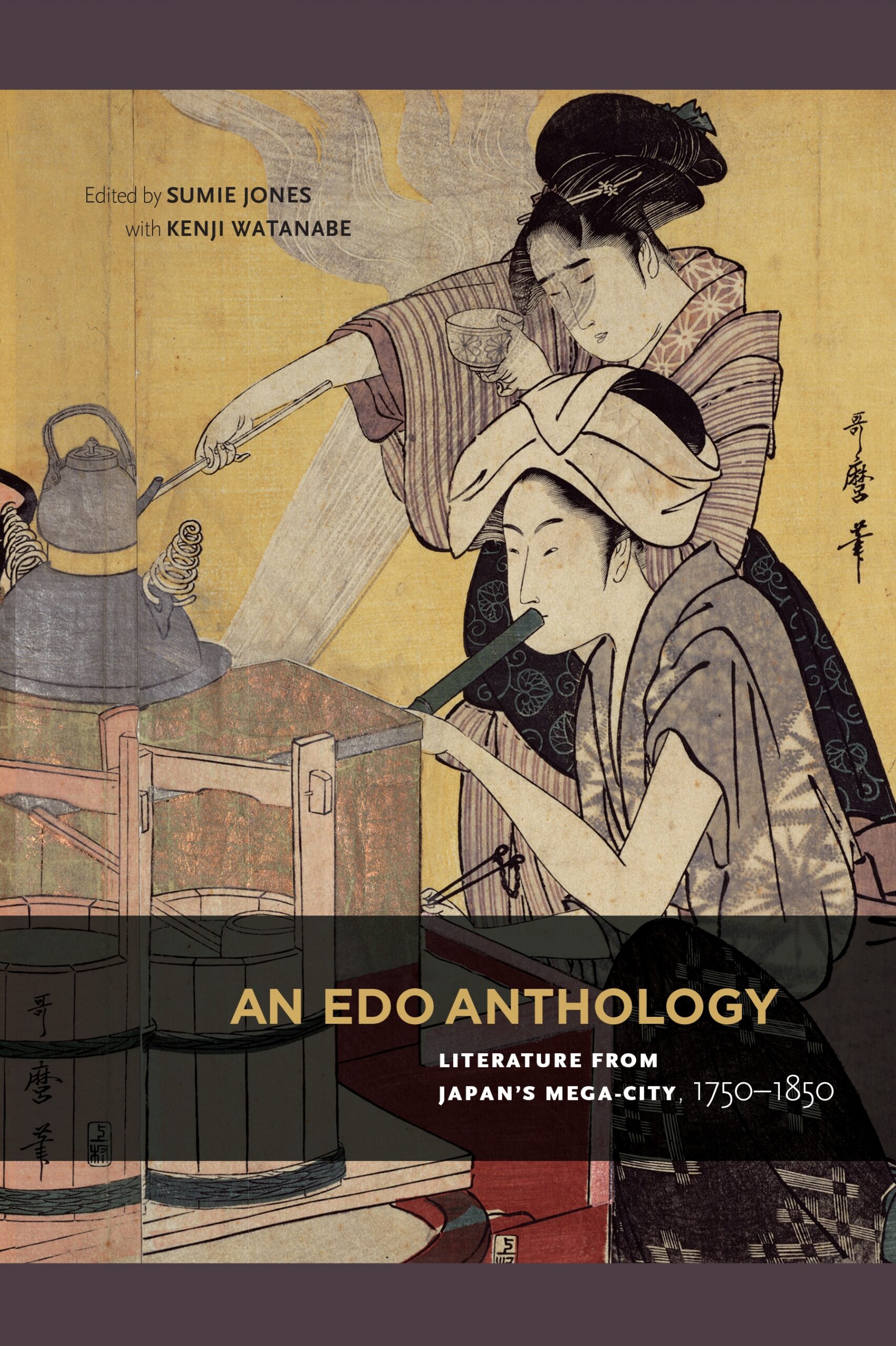An Edo Anthology: Literature from Japan’s Mega-City, 1750-1850
- About the Book
-
During the eighteenth century, Edo (today’s Tokyo) became the world’s largest city, quickly surpassing London and Paris. Its rapidly expanding population and flourishing economy encouraged the development of a thriving popular culture. Innovative and ambitious young authors and artists soon began to look beyond the established categories of poetry, drama, and prose, banding together to invent completely new literary forms that focused on the fun and charm of Edo. Their writings were sometimes witty, wild, and bawdy, and other times sensitive, wise, and polished. Now some of these high spirited works, celebrating the rapid changes, extraordinary events, and scandalous news of the day, have been collected in an accessible volume highlighting the city life of Edo.
Edo’s urban consumers demanded visual presentations and performances in all genres. Novelties such as books with text and art on the same page were highly sought after, as were kabuki plays and the polychrome prints that often shared the same themes, characters, and even jokes. Popular interest in sex and entertainment focused attention on the theatre district and “pleasure quarters,” which became the chief backdrops for the literature and arts of the period. Gesaku, or “playful writing,” invented in the mid-eighteenth century, satirized the government and samurai behavior while parodying the classics. These entertaining new styles bred genres that appealed to the masses. Among the bestsellers were lengthy serialized heroic epics, revenge dramas, ghost and monster stories, romantic melodramas, and comedies that featured common folk.
An Edo Anthology offers distinctive and engaging examples of this broad range of genres and media. It includes both well-known masterpieces and unusual examples from the city’s counterculture, some popular with intellectuals, others with wider appeal. Some of the translations presented here are the first available in English and many are based on first editions. In bringing together these important and expertly translated Edo texts in a single volume, this collection will be warmly welcomed by students and interested readers of Japanese literature and popular culture.
- About the Author(s)
-
Sumie Jones, Editor
Sumie Jones, a specialist in eighteenth-century comparative literature and Edo arts, is professor emerita of East Asian languages and cultures and comparative literature and a residential fellow of the Institute for Advanced Study, Indiana University, Bloomington. She is the recipient of the 2018–19 Lindsley and Masao Miyoshi Translation Prize for lifetime achievement as a translator, presented by the Donald Keene Center of Japanese Culture, Columbia University.Kenji Watanabe, Editor
Kenji Watanabe, an expert in Edo-period literature and society, is professor emeritus of Rikkyo University and academic dean of the Jiyugakuen College, Tokyo.
Contributors
- Faith Bach
- Mark Borer
- Caryn Callahan
- Robert Campbell
- Joel Cohn
- Alan Cummings
- Chris Drake
- Valerie L. Durham
- William J. Farge
- Bettina Gramlich-Oka
- Howard Hibbett
- Sumie Jones
- Adam Kabat
- Adam L. Kern
- Sara Langer
- Andrew Markus
- Dylan McGee
- Christopher A. Robins
- Timon Screech
- William Ferguson Sibley
- David Sitkin
- John Solt
- Roger K. Thomas
- Charles Vilnis
- Jason Webb
- Ellen B. Widmer
- Reviews and Endorsements
-
- Anyone who wishes to soak up the atmosphere of Japanese urban life in those marvellous years before Edo became Tokyo need look no further than this anthology. Designed around six thematic categories, the book leads us right to the heart of the colorful, the earthy, the comic, the scabrous world of what in the mid-eighteenth century was in all likelihood the largest city in the world. A special strength of this collection is its successful attempt to capture one of the most remarkable aspects of popular literature of the time: the visual excitement of the woodblock printed page. A superb teaching resource that puts Edo within reach of the classroom.
—Richard Bowring, Professor Emeritus, University of Cambridge - This anthology brings together the best and most important translations of late Edo texts into a single volume that synthesizes the work of a generation of scholars in the field and will likely inspire another generation to follow. It provides readers with an engaging, highly accessible, and thematically organized entry into the varied genres and authors of the period.
—Paul Gordon Schalow, Rutgers University - Today's Japan Cool has its origin in the Edo period, where parodies were the norm, far more prized than the originals, while art-forms and genres merely existed to be crossed over and intermingled. Writers and readers easily swapped their roles; poets, novelists, artists, and musicians constantly worked together and/or trespassed into each other's territory. As yet, few of the literary masterworks of this intriguing culture have been translated into foreign languages due to the intrinsic difficulty of the job. This book is the fruit of over thirty years' group work by top-class specialists who know Edo best but love it even better.
—Koji Kawamoto, Professor Emeritus, University of Tokyo
- Anyone who wishes to soak up the atmosphere of Japanese urban life in those marvellous years before Edo became Tokyo need look no further than this anthology. Designed around six thematic categories, the book leads us right to the heart of the colorful, the earthy, the comic, the scabrous world of what in the mid-eighteenth century was in all likelihood the largest city in the world. A special strength of this collection is its successful attempt to capture one of the most remarkable aspects of popular literature of the time: the visual excitement of the woodblock printed page. A superb teaching resource that puts Edo within reach of the classroom.
- Supporting Resources
-





